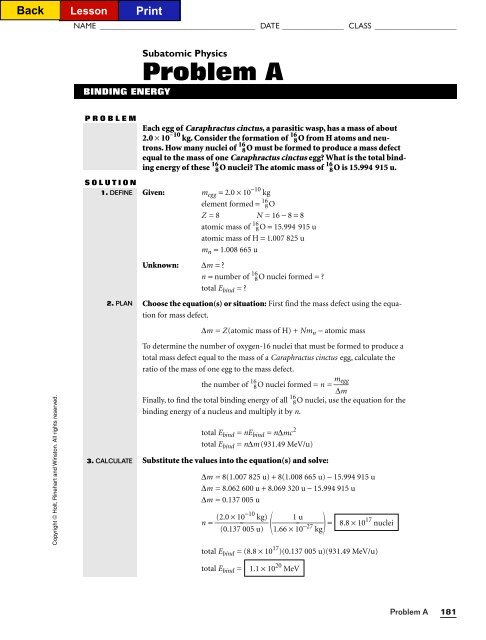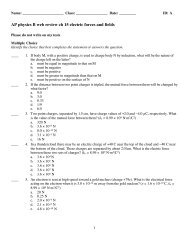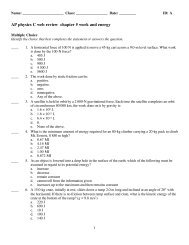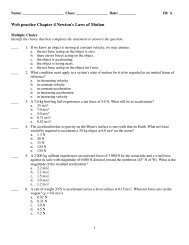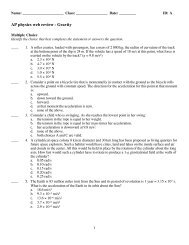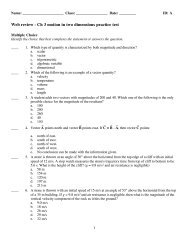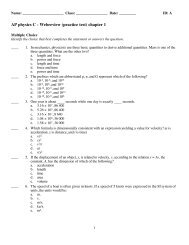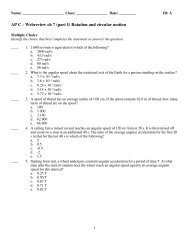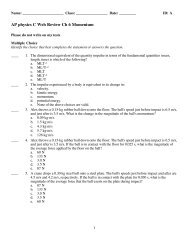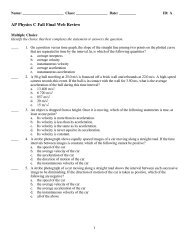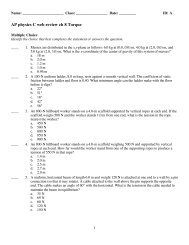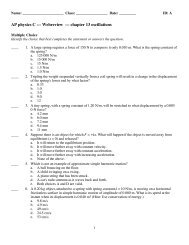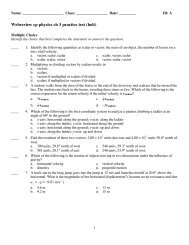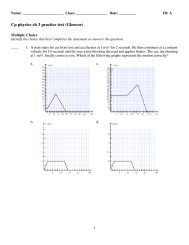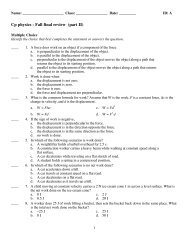Problem A Copyright reserved
binding energy - Planet Holloway
binding energy - Planet Holloway
- No tags were found...
Create successful ePaper yourself
Turn your PDF publications into a flip-book with our unique Google optimized e-Paper software.
NAME ______________________________________ DATE _______________ CLASS ____________________<br />
Subatomic Physics<br />
<strong>Problem</strong> A<br />
BINDING ENERGY<br />
PROBLEM<br />
Each egg of Caraphractus cinctus, a parasitic wasp, has a mass of about<br />
2.0 × 10 −10 kg. Consider the formation of 16 8O from H atoms and neutrons.<br />
How many nuclei of 16 8O must be formed to produce a mass defect<br />
equal to the mass of one Caraphractus cinctus egg? What is the total binding<br />
energy of these 16 8O nuclei? The atomic mass of 16 8O is 15.994 915 u.<br />
<strong>Copyright</strong> © Holt, Rinehart and Winston. All rights <strong>reserved</strong>.<br />
SOLUTION<br />
1. DEFINE<br />
2. PLAN<br />
3. CALCULATE<br />
Given:<br />
m egg = 2.0 × 10 −10 kg<br />
element formed = 16 8O<br />
Z = 8 N = 16 − 8 = 8<br />
atomic mass of 16 8O = 15.994 915 u<br />
atomic mass of H = 1.007 825 u<br />
m n = 1.008 665 u<br />
Unknown: ∆m = ?<br />
n = number of 16 8O nuclei formed = ?<br />
total E bind = ?<br />
Choose the equation(s) or situation: First find the mass defect using the equation<br />
for mass defect.<br />
∆m = Z(atomic mass of H) + Nm n − atomic mass<br />
To determine the number of oxygen-16 nuclei that must be formed to produce a<br />
total mass defect equal to the mass of a Caraphractus cinctus egg, calculate the<br />
ratio of the mass of one egg to the mass defect.<br />
the number of 16 8O nuclei formed = n = ⎯ m egg<br />
⎯<br />
∆m<br />
Finally, to find the total binding energy of all 16 8O nuclei, use the equation for the<br />
binding energy of a nucleus and multiply it by n.<br />
total E bind = nE bind = n∆mc 2<br />
total E bind = n∆m (931.49 MeV/u)<br />
Substitute the values into the equation(s) and solve:<br />
∆m = 8(1.007 825 u) + 8(1.008 665 u) − 15.994 915 u<br />
∆m = 8.062 600 u + 8.069 320 u − 15.994 915 u<br />
∆m = 0.137 005 u<br />
n = ⎯ (2 −10<br />
. 0 × 10 kg)<br />
1 u<br />
⎯<br />
( 0.137<br />
005<br />
u)<br />
<br />
⎯⎯ 1.66 × 10 −27 kg <br />
= 8.8 × 10 17 nuclei<br />
total E bind = (8.8 × 10 17 )(0.137 005 u)(931.49 MeV/u)<br />
total E bind =<br />
1.1 × 10 20 MeV<br />
<strong>Problem</strong> A 181
NAME ______________________________________ DATE _______________ CLASS ____________________<br />
4. EVALUATE<br />
For every nucleus of 16 8O formed, the mass defect is 0.137 005 u, and the mass of<br />
the nucleus formed is 15.994 915 u. When ∆m has a total value of 2.0 × 10 −10 kg,<br />
8.8 × 10 17 nuclei, or 2.3 × 10 −8 kg of 16 8O will have formed.<br />
ADDITIONAL PRACTICE<br />
1. In 1993, the United States had more than 100 operational nuclear reactors<br />
producing about 30 percent of the world’s nuclear energy, or 610 TW •h.<br />
a. Find the mass defect corresponding to a binding energy equal to<br />
that energy output.<br />
b. How many 2 1H nuclei would be needed to provide this mass defect?<br />
c. How many 56 26Fe nuclei would be needed to provide this mass defect?<br />
d. How many 226 88Ra nuclei would be needed to provide this mass defect?<br />
2. In 1976, Montreal hosted the Summer Olympics. To complete the new<br />
velodrome, the 4.1 × 10 7 kg roof had to be raised 10.0 cm to be placed in<br />
the exact position.<br />
a. Find the energy needed to raise the roof.<br />
b. Find the mass of 26Fe 56 that is formed when an amount of energy<br />
equal to that calculated in part (a) is obtained from binding H atoms<br />
and neutrons in iron-56 nuclei.<br />
3. Nuclear-energy production worldwide was 2.0 × 10 3 TW•h in 1993. What<br />
mass of 235<br />
92U releases an equivalent amount of energy in the form of binding<br />
energy?<br />
4. In 1993, the United States burned about 2.00 × 10 8 kg of coal to produce<br />
about 2.1 × 10 19 J of energy. Suppose that instead of burning coal, you<br />
obtain energy by forming coal ( 12 6C) out of H atoms and neutrons. What<br />
amount of coal must be formed to provide 2.1 × 10 19 J of energy? Assume<br />
100 percent efficiency.<br />
5. The sun radiates energy at a rate of 3.9 × 10 26 J/s. Suppose that all the<br />
sun’s energy occurs because of the formation of 4 2He from H atoms and<br />
neutrons. Find the number of reactions that take place each second.<br />
6. Sulzer Brothers, a Swiss company, made powerful diesel engines for the<br />
container ships built for American President Lines. The power of each<br />
12-cylinder engine is about 42 MW. Suppose the turbines use the formation<br />
of 14 7N for the energy-releasing process. What mass of nitrogen<br />
would have to be formed to provide enough energy for 24 h of continuous<br />
work? Assume the turbines are 100 percent efficient.<br />
7. A hundred years ago, the most powerful hydroelectric plant in the world<br />
produced 3.84 × 10 7 W of electric power. Find the total mass of 12 6C<br />
atoms that must be formed each second from H atoms and neutrons to<br />
produce the same power output.<br />
<strong>Copyright</strong> © Holt, Rinehart and Winston. All rights <strong>reserved</strong>.<br />
182<br />
Holt Physics <strong>Problem</strong> Workbook
<strong>Problem</strong> Workbook Solutions<br />
Additional Practice A<br />
Subatomic Physics<br />
Givens<br />
1. E = 610 TW •h<br />
Solutions<br />
E (610 × 10 9 kW •h)(3.6 × 10 6 J/kW •h)<br />
a. ∆m = ⎯⎯ c 2 = ⎯⎯⎯⎯<br />
(3.00 × 10 8 m/s) 2<br />
∆m =<br />
24 kg<br />
atomic mass of 1 2 H =<br />
2.014 102 u<br />
atomic mass of 56 26 Fe =<br />
55.934 940 u<br />
∆m<br />
24 kg<br />
b. n = ⎯⎯ atomic mass of 2 = ⎯⎯⎯⎯<br />
1 H (1.66 × 10 −27 kg/u)(2.014 102 u)<br />
n =<br />
7.2 × 10 27 1 2 H nuclei<br />
∆m<br />
24 kg<br />
c. n = ⎯⎯⎯ = ⎯⎯⎯⎯<br />
atomic mass of 56 (1.66 × 10 −27 26 Fe<br />
kg/u)(55.934 940 u)<br />
II<br />
n =<br />
2.6 × 10 26 26<br />
56 Fe nuclei<br />
atomic mass of 226 88Ra =<br />
226.025 402 u<br />
∆m<br />
24 kg<br />
d. n = ⎯⎯⎯ = ⎯⎯⎯⎯<br />
atomic mass of 226<br />
88 Ra (1.66 × 10 −27 kg/u)(226.025 402 u)<br />
25 226<br />
n = 6.4 × 10 88Ra nuclei<br />
HRW material copyrighted under notice appearing earlier in this book.<br />
2. m = 4.1 × 10 7 kg<br />
h = 10.0 cm<br />
Z = 26<br />
N = 56 − 26 = 30<br />
m H = 1.007 825 u<br />
m n = 1.008 665 u<br />
atomic mass of 56 26 Fe =<br />
55.934 940 u<br />
a. E = mgh = (4.1 × 10 7 kg)(9.81 m/s 2 )(0.100 m)<br />
E =<br />
4.0 × 10 7 J<br />
(4.0 × 10 7 J)(1 × 10 −6 MeV/eV)<br />
b. E tot = ⎯⎯⎯⎯ =2.5 × 10 20 MeV<br />
(1.60 × 10 −19 J/eV)<br />
2.5 × 10 20 MeV<br />
∆m tot = ⎯⎯ =2.7 × 10 17 u<br />
931.49 MeV/u<br />
∆m = Z(atomic mass of H) + Nm n − atomic mass of 56 26 Fe<br />
∆m = 26(1.007 825 u) + 30(1.008 665 u) − 55.934 940 u<br />
∆m = 0.528 460 u<br />
E bind = (0.528 460 u) <br />
931.49 ⎯ M eV<br />
u<br />
⎯<br />
E bind = 492.26 MeV<br />
Etot<br />
2.5 × 10 20 MeV<br />
n = ⎯⎯ = ⎯⎯ =5.1 × 10 17 reactions<br />
E bind<br />
492.26 MeV<br />
m tot = (5.1 × 10 17 )(55.934 940 u) <br />
1.66 × 10 −27 ⎯ k g<br />
⎯<br />
u <br />
= 4.7 × 10 −8 kg<br />
Section Two—<strong>Problem</strong> Workbook Solutions II Ch. 22–1
Givens<br />
3. E = 2.0 × 10 3 TW •h =<br />
2.0 × 10 15 W •h<br />
atomic mass of 235<br />
92U =<br />
235.043 924 u<br />
atomic mass of H =<br />
1.007 825 u<br />
m n = 1.008 665 u<br />
Z = 92<br />
N = 235 − 92 = 143<br />
Solutions<br />
∆m = Z(atomic mass of H) + Nm n − atomic mass of 235<br />
92U<br />
∆m = 92(1.007 825 u) + 143(1.008 665 u) − 235.043 924 u = 1.915 071 u<br />
E bind = (1.915 071 u) <br />
931.49 ⎯ M eV<br />
u<br />
⎯ = 1.7839 × 10 3 MeV = 1.7839 × 10 9 eV<br />
E bind = (1.7839 × 10 9 eV) <br />
1.60 × 10 −19 ⎯<br />
e<br />
JV ⎯ = 2.85 × 10−10 J<br />
E = (2.0 × 10 15 W •h) <br />
⎯ 3.60 × 10 3 s<br />
⎯<br />
h <br />
= 7.2 × 10 18 J<br />
18<br />
E 7.2<br />
× 10<br />
J<br />
n = ⎯⎯ = ⎯⎯ Eb ind 2 .85<br />
× 10−<br />
10 = 2.5 × 10 28 reactions<br />
J<br />
m tot = (2.5 × 10 28 )(235.043 924 u) <br />
1.66 × 10 −27 k g<br />
⎯⎯ u <br />
= 9.8 × 10 3 kg<br />
II<br />
4. E = 2.1 × 10 19 J<br />
atomic mass of 12 6C =<br />
12.000 000 u<br />
atomic mass of H =<br />
1.007 825 u<br />
m n = 1.008 665 u<br />
Z = 6<br />
N = 12 − 6 = 6<br />
∆m = Z(atomic mass of H) + Nm n − atomic mass of 12 6C<br />
∆m = 6(1.007 825 u) + 6(1.008 665 u) − 12.000 000 u<br />
∆m = 9.8940 × 10 −2 u<br />
E bind = (9.8940 × 10 −2 u) <br />
931.49 ⎯ M eV<br />
u<br />
⎯ = 92.162 MeV<br />
E bind = (92.162 × 10 6 eV) <br />
1.60 × 10 −19 ⎯ e<br />
JV ⎯ = 1.47 × 10−11 J<br />
19<br />
E 2.1<br />
× 10<br />
J<br />
n = ⎯⎯ = ⎯⎯ Eb ind 1 .47<br />
× 10−<br />
11 = 1.4 × 10 30 reactions<br />
J<br />
m tot = (1.4 × 10 30 )(12.000 000 u) <br />
1.66 × 10 −27 ⎯ k g<br />
⎯<br />
u <br />
= 2.8 × 10 4 kg<br />
5. P tot = 3.9 × 10 26 J/s<br />
Z = 2<br />
N = 4 − 2 = 2<br />
atomic mass of 4 2He =<br />
4.002 602 u<br />
atomic mass of H =<br />
1.007 825 u<br />
m n =1.008 665 u<br />
6. P = 42 MW = 42 × 10 6 W<br />
atomic mass of 14 7N =<br />
14.003 074 u<br />
atomic mass of H =<br />
1.007 825 u<br />
m n = 1.008 665 u<br />
Z = 7<br />
N = 14 − 7 = 7<br />
∆t = 24 h<br />
∆m = Z(atomic mass of H) + Nm n − atomic mass of 4 2He<br />
∆m = (2)(1.007 825 u) + (2)(1.008 665 u) − 4.002 602 u<br />
∆m = 0.030 378 u<br />
E = (0.030 378 u) <br />
931.49 ⎯ M eV<br />
u ⎯<br />
E = 28.297 MeV<br />
n<br />
⎯⎯ = ⎯ P tot (3.9 × 10 26 J/s)(1 × 10 −6 MeV/eV)<br />
⎯ = ⎯⎯⎯⎯<br />
∆t<br />
E (1.60 × 10 −19 J/eV)(28.297 MeV)<br />
n<br />
⎯⎯ = 8.6 × 10 37 reactions/s<br />
∆t<br />
∆m = Z(atomic mass of H) + Nm n − atomic mass of 14 7N<br />
∆m = 7(1.007 825 u) + 7(1.008 665 u) − 14.003 074 u<br />
∆m = 0.112 356 u<br />
E bind = (0.112 356 u) <br />
931.49 ⎯ M eV<br />
u ⎯ = 104.66 MeV<br />
E bind = (104.66 × 10 6 eV) <br />
1.60 × 10 −19 ⎯ e<br />
JV ⎯ = 1.67 × 10−11 J<br />
P∆t<br />
n = ⎯⎯ = E bind<br />
(42 × 10 6 W)(24 h)(3600 s/h)<br />
⎯⎯⎯<br />
1.67 × 10 −11 J<br />
=2.2 × 10 23 reactions<br />
m tot = (2.2 × 10 23 )(14.003 074 u) <br />
1.66 × 10 −27 ⎯ k g<br />
⎯<br />
u <br />
= 5.1 × 10 −3 kg = 5.1 g<br />
HRW material copyrighted under notice appearing earlier in this book.<br />
II Ch. 22–2<br />
Holt Physics Solution Manual
Givens<br />
7. P = 3.84 × 10 7 W<br />
atomic mass of 12 6C =<br />
12.000 000 u<br />
atomic mass of H =<br />
1.007 825 u<br />
m n = 1.008 665 u<br />
Z = 6<br />
N = 12 − 6 = 6<br />
Solutions<br />
∆m = Z(atomic mass of H) + Nm n − atomic mass of 12 6C<br />
∆m = 6(1.007 825 u) + 6(1.008 665 u) − 12.000 000 u<br />
∆m = 9.8940 × 10 −2 u<br />
E bind = (9.8940 × 10 −2 u) <br />
931.49 × 10 6 ⎯ e V<br />
u<br />
⎯ 1.60 × 10 −19 J<br />
⎯ e V ⎯ <br />
E bind = 1.47 × 10 −11 J<br />
7<br />
n P 3.<br />
84<br />
× 10<br />
W<br />
⎯⎯ = ⎯⎯ = ⎯⎯ ∆t<br />
Eb ind 1 . 47<br />
× 10−<br />
1 1 = 2.61 × 10 18 reactions/s<br />
J<br />
mt<br />
⎯<br />
∆<br />
⎯ ot<br />
t<br />
= (2.61 × 10 18 s −1 )(12.000 000 u) 1.66 × 10 −27 ⎯ k g<br />
u<br />
⎯ <br />
= 5.20 × 10 −8 kg/s<br />
Additional Practice B<br />
1. 238<br />
92U + 0 1 n → X<br />
X → 939 93Np + −1 0 e + v <br />
239<br />
93 Np → 239 94Pu + −1 0 e + v <br />
mass number of X = 238 + 1 = 239<br />
atomic number of X = 92 + 0 = 92 (uranium)<br />
X = 239<br />
92U<br />
The equations are as follows:<br />
238<br />
92 U + 1 0 n → 239<br />
92U<br />
239<br />
92 U → 939 93Np + −1 0 e + v <br />
239<br />
93 Np → 239 94Pu + −1 0 e + v <br />
II<br />
HRW material copyrighted under notice appearing earlier in this book.<br />
2. X → Y + 4 2He<br />
Y → Z + 4 2He<br />
Z → 212 83Bi + −1 0 e + v <br />
mass number of Z = 212 + 0 = 212<br />
atomic number of Z = 83 − 1 = 82 (lead)<br />
Z = 212 82Pb<br />
mass number of Y = 212 + 4 = 216<br />
atomic number of Y = 82 + 2 = 84 (polonium)<br />
Y = 216 84Po<br />
mass number of X = 216 + 4 = 220<br />
atomic number of X = 84 + 2 = 86 (radon)<br />
X = 220 86Rn<br />
The equations are as follows:<br />
220<br />
86 Rn → 216 84Po + 4 2He<br />
216<br />
84 Po → 212 82Pb + 4 2He<br />
212<br />
82 Pb → 212 83Bi + −1 0 e + v <br />
3. X → 135 56Ba + 0 −1 e + v mass number of X = 135 + 0 = 135<br />
atomic number of X = 56 + (−1) = 55 (cesium)<br />
X = 135<br />
55 Cs<br />
135<br />
55 Cs → 135 56Ba + −1 0 e + v <br />
Section Two—<strong>Problem</strong> Workbook Solutions II Ch. 22–3


